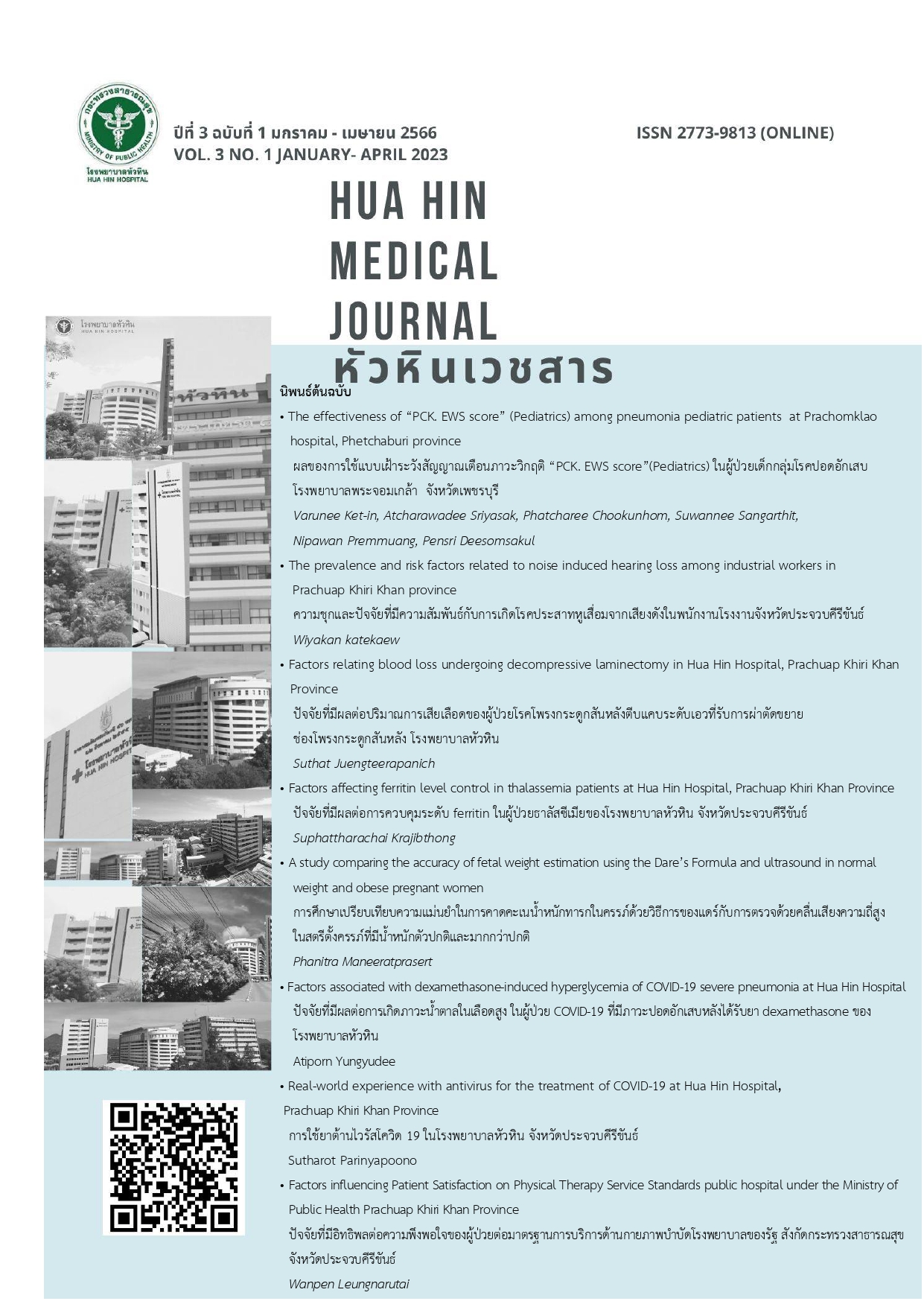Factors affecting ferritin level control in thalassemia patients
Keywords:
Thalassemia, Ferritin, Risk factorAbstract
Background: Thalassemia is a genetic disease caused by abnormal of globin protein chains, which is a component of red blood cells, so the pathology of this disease results from anemia. In Thailand has high prevalence of this disease. The current main treatments are blood transfusion and iron chelation. Iron overload is a major complication of thalassemia, resulting in abnormal functioning of various organs.
Objective: The purpose was to study the factors having effects on the control of ferritin levels in thalassemia patients at Hua Hin Hospital, Prachuap Khiri Khan Province.
Method: This is a retrospective analytical study. Data were collected from medical records of outpatients diagnosed with thalassemia at the outpatient department Hua Hin Hospital, Prachuap Khiri Khan Province that were recorded in the medical 2020 during January 1, 2017 to May 31, 2022 for a period of 5 years and 5 months. The research instrument was a record of factors affecting ferritin control in thalassemia patients. The data were presented in percentage, average and standard deviation; t-test independent and chi-square test were implemented for the analysis of the factors relating on the control of ferritin levels.
Result: Of the total 222 eligible patients, the mean hemoglobin in 1 year, the number of blood transfusions in 1 year, the type of thalassemia, and iron chelation therapy had a statistically significant effect on the control of ferritin levels (p<0.001). Sex and splenectomy had a statistically significant effect on ferritin control (p<0.05), whereas age had no effect on ferritin control.
Conclusion: Factors affecting the control of ferritin levels in thalassemia patients, some factors may be factors that cannot be changed. However, it is the role of the healthcare professionals who care for these patients to be more closely monitored for ferritin levels in patients with these risk factors.
References
จิตสุดา บัวขาว (บก.). (2560). แนวทางการดูแลรักษาผู้ป่วยธาลัสซีเมียใน เวชปฏิบัติทั่วไป. กรุงเทพ: สำนักงานกิจการ โรงพิมพ์ องค์การสงเคราะห์ทหารผ่านศึกใน พระบรมราชูปถัมภ์.
Higgs DR. Thalassaemia. The Lancet. 2012;379(9813):373–83.
Lippi G. Updated worldwide epidemiology of inherited Erythrocyte Disorders. Acta Haematologica. 2019;143(3):196–203.
Fucharoen S. Alpha- and beta-thalassemia in Thailand. Annals of the New York Academy of Sciences. 1998;850(1 COOLEY'S ANEM):412–4.
Ministry of Public Health Thailand. Thalassemia in Thailand: 2018. Available from: https://pr.moph.go.th/?url=pr/ detail/all/02/116500 Accessed 17 January 2020.
Ministry of Public Health. HDC service.;[access 18/6/2022].from https://hdcservice.moph.go.th/hdc/ main/index.php
Ahmed MH. Hemoglobin: Structure, function, and allostery. Subcellular Biochemistry. 2020;345–82.
นภชาญ เอื้อประเสริฐ (บก.). (2563). Essential clinical hematology: Essential content for internist. กรุงเทพ: จุฬาลงกรณ์มหาวิทยาลัย.
Taher AT. Thalassaemia. The Lancet. 2018;391(10116):155–67.
Brancaleoni V. Laboratory diagnosis of thalassemia. International Journal of Laboratory Hematology. 2016;38:32–40.
Borgna-Pignatti C. Survival and complications in patients with thalassemia major treated with transfusion and deferoxamine. Haematologica. 2004;89:1187–93.
Modell B. Survival in β-thalassaemia major in the UK: Data from the UK Thalassaemia Register. The Lancet. 2000;355(9220):2051–2.
Motta I. Beta thalassemia: New therapeutic options beyond transfusion and iron chelation. Drugs. 2020;80(11):1053–63.
Viprakasit V. Iron chelation therapy in the management of thalassemia: The Asian perspectives. International Journal of Hematology. 2009;90(4):435–45.
Aydinok Y. Iron chelation therapy as a modality of management. Hematology/Oncology Clinics of North America. 2018;32(2):261–75.
Shah R. Serum ferritin in Thalassemia intermedia. Indian Journal of Hematology and Blood Transfusion. 2013;30(4):281–5.
Buonanno G. Serum ferritin in
β-thalassaemia intermedia. Scandinavian Journal of Haematology. 2009;32(1):83–7.
Gümruk F. Reevaluation of iron absorption and serum ferritin in
β-thalassemia intermedia. Pediatric Hematology and Oncology. 1992;9(4):359–63.
Pakbaz Z. Serum ferritin underestimates liver iron concentration in transfusion-independent thalassemia patients as compared to regularly transfused thalassemia and sickle cell patients. Pediatric Blood & Cancer. 2007;49(3):329–32.
Pootrakul P. Serum ferritin levels in thalassemia and the effect of splenectomy. Acta Haematologica. 1981;66(4):244–50.
Downloads
Published
How to Cite
Issue
Section
License
Copyright (c) 2023 Hua-Hin Hospital

This work is licensed under a Creative Commons Attribution-NonCommercial-NoDerivatives 4.0 International License.
บทความที่ได้รับการตีพิมพ์ในวารสารหัวหินเวชสาร เป็นลิขสิทธิ์ของโรงพยาบาลหัวหิน
บทความที่ลงพิมพ์ใน วารสารหัวหินเวชสาร ถือว่าเป็นความเห็นส่วนตัวของผู้เขียนคณะบรรณาธิการไม่จำเป็นต้องเห็นด้วย ผู้เขียนต้องรับผิดชอบต่อบทความของตนเอง







